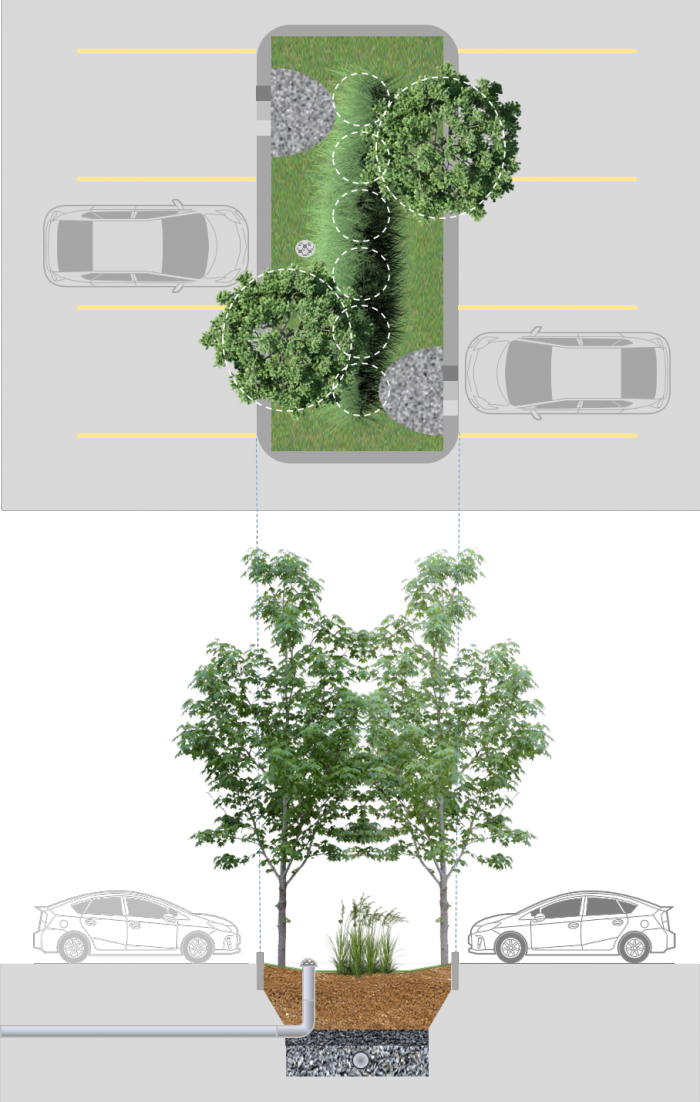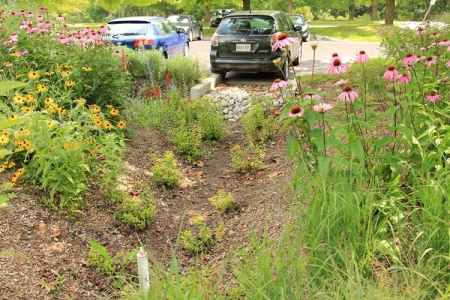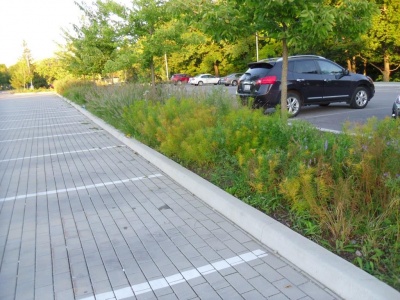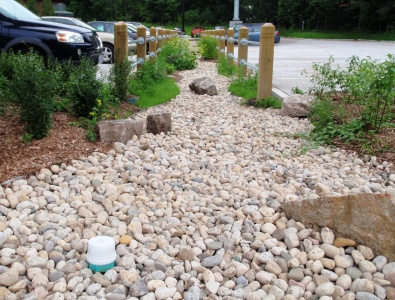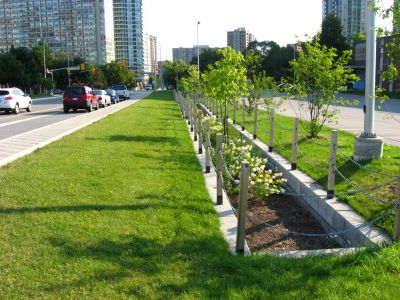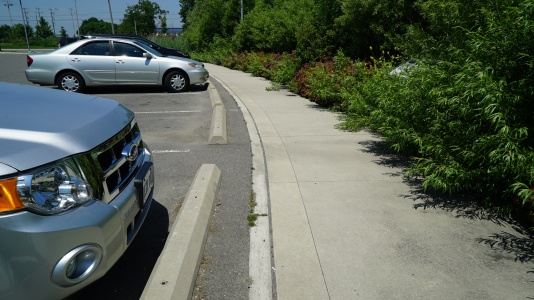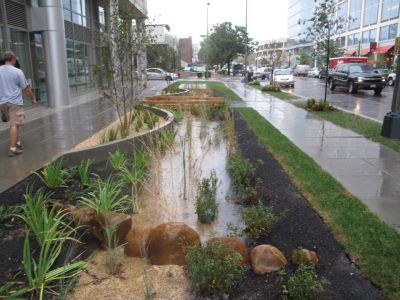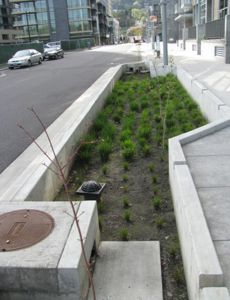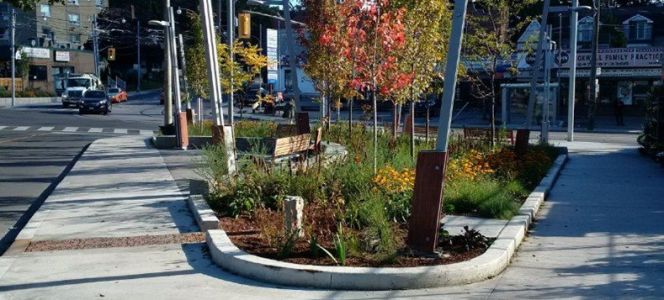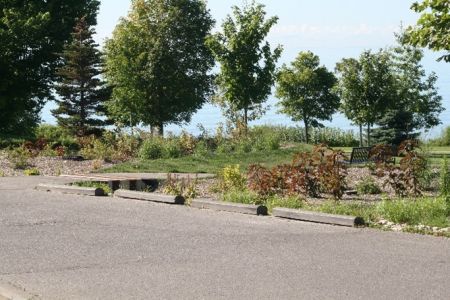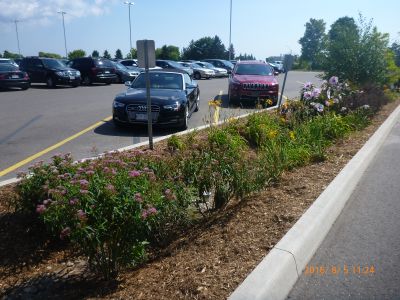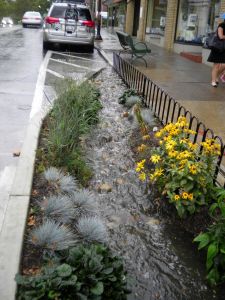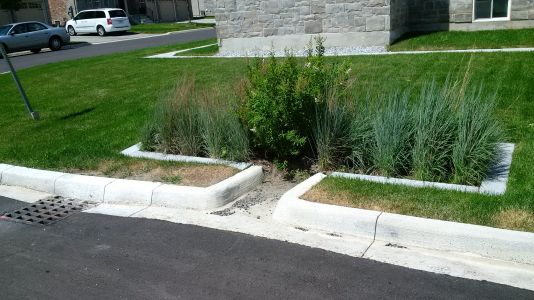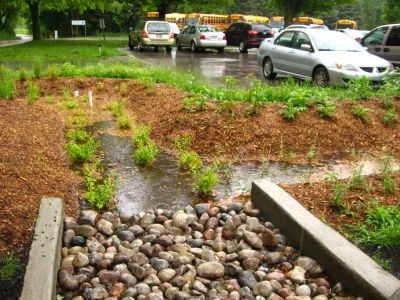Difference between revisions of "Bioretention: Parking lots"
Jenny Hill (talk | contribs) m |
Kyle menken (talk | contribs) |
||
| (14 intermediate revisions by one other user not shown) | |||
| Line 1: | Line 1: | ||
| − | + | <imagemap> | |
| + | Image:Bioretention cell.png|thumb|700 px|This is an image map of an extended tree pit, clicking on components will load the appropriate article. | ||
| + | circle 573 193 88 [[Trees]] | ||
| + | circle 374 441 89 [[Trees]] | ||
| + | poly 359 1251 359 1141 249 1083 235 948 276 830 329 714 400 721 466 821 555 721 617 710 668 833 713 972 689 1091 598 1125 580 1245 568 1248 539 1112 412 1115 379 1148 371 1251 [[Trees]] | ||
| + | rect 435 97 502 541 [[Graminoids: List]] | ||
| + | rect 436 1171 508 1260 [[Graminoids: List]] | ||
| + | poly 351 88 403 99 435 145 410 188 353 202[[Forebays]] | ||
| + | poly 571 449 516 464 494 505 515 550 571 563[[Forebays]] | ||
| + | rect 331 110 350 177 [[Curb cuts]] | ||
| + | rect 574 473 593 538 [[Curb cuts]] | ||
| + | circle 395 321 13 [[Overflow]] | ||
| + | poly 391 1255 396 1243 410 1249 407 1337 393 1349 2 1343 -1 1329 393 1330 [[Overflow]] | ||
| + | poly 410 1259 411 1334 552 1334 585 1280 582 1251 527 1262 526 1262 [[Bioretention: Filter media]] | ||
| + | poly 345 1250 389 1258 390 1327 367 1327 344 1284 [[Bioretention: Filter media]] | ||
| + | rect 406 1335 555 1355 [[Choking layer]] | ||
| + | rect 369 1356 457 1395 [[Reservoir aggregate]] | ||
| + | rect 482 1357 556 1394 [[Reservoir aggregate]] | ||
| + | circle 468 1375 12 [[Underdrain]] | ||
| + | </imagemap> | ||
| + | |||
| + | On commercial, industrial and multi-unit developments, a popular choice is to integrate [[bioretention]] into parking lot landscaped areas. These distributed cells typically accept sheet flow through multiple curb cuts, have shallow depression storage ≤ 100 mm, and a total area of 5 -200 m<sup>2</sup>. Although many parking lot schemes include long linear bioretention cells (≥ 0.6 m wide), infiltration is optimized by having a level grade and a level base, unlike a [[Bioswales|bioswale]]. | ||
| + | |||
| + | ===Winter maintenance=== | ||
| + | Salt can be damaging to the planting in parking lot bioretention. To help minimize this, bioretention practices adjacent to parking areas should always have an [[underdrain]] and salt use be reduced through good design and planning of the [[salt management| parking lot]]. | ||
| + | |||
| + | ==Gallery== | ||
| + | {{:Bioretention cells: Gallery}} | ||
| + | |||
| + | ==See Also== | ||
| + | *[[Bioretention: Streetscapes]] | ||
| + | *[[Stormwater planters]] | ||
| + | *[[Rain gardens]] | ||
| + | ---- | ||
| + | *[[Trees]] | ||
| + | *[[Perennials: List| Perennials]] | ||
| + | *[[Inlets]] | ||
| + | *[[Forebays]] | ||
| + | *[[Overflow]] | ||
| + | *[[Mulch]] | ||
| + | *[[Bioretention:_Filter_media|Filter media]] | ||
| + | *[[Choking layer]] | ||
| + | *[[Reservoir_aggregate|Reservoir]] | ||
| + | *[[underdrain]] | ||
Revision as of 19:33, 15 January 2019
On commercial, industrial and multi-unit developments, a popular choice is to integrate bioretention into parking lot landscaped areas. These distributed cells typically accept sheet flow through multiple curb cuts, have shallow depression storage ≤ 100 mm, and a total area of 5 -200 m2. Although many parking lot schemes include long linear bioretention cells (≥ 0.6 m wide), infiltration is optimized by having a level grade and a level base, unlike a bioswale.
Winter maintenance[edit]
Salt can be damaging to the planting in parking lot bioretention. To help minimize this, bioretention practices adjacent to parking areas should always have an underdrain and salt use be reduced through good design and planning of the parking lot.
Gallery[edit]
Parking lot bioretention with surface ponding well in foreground, Kortright Centre, Vaughan, ON. Read about the performance of this practice in the technical brief.
Parking lot bioretention sharing underground reservoir with adjacent permeable paving, Edwards Gardens, Toronto, ON. Read a case study about it here.
Parking lot bioretention with decorative stone for erosion control, and perforated pipe access standpipe in foreground, Earth Rangers Centre, Vaughan, ON. Read about the performance of this practice in the technical brief.
The sunken curb holds the edge of the asphalt pavement and lets water freely flow to the bioretention cell beside the 7sigma parking lot in Minneapolis, MN (USA)
Photo credit:Brian AshBioretention cells on Elm Drive, Mississauga, ON, with vertical sides and hardscape perimeter receive road runoff via leader pipes from road catch basin inlets. Read about the stormwater system at this site in the performance assessment report.
Bioretention bump out in a dense urban setting receiving runoff via side inlet catch basin and curb openings on the walkway side of the installation.
Fairford Parkette featuring a bioretention cell retrofitted into a roadway in downtown Toronto, ON. Read a case study about it here.
Parking lot bioretention cell at IMAX corporate headquarters in Mississauga, ON. Read about the IMAX stormwater system in the performance assessment report
Bioretention cell receiving road runoff in the Wychwood neighbourhood of Brampton, ON. The nearby catch basin conveys overflows during major rain events. Read about the stormwater system in this community in the performance assessment report.
